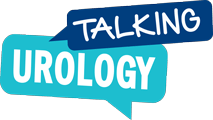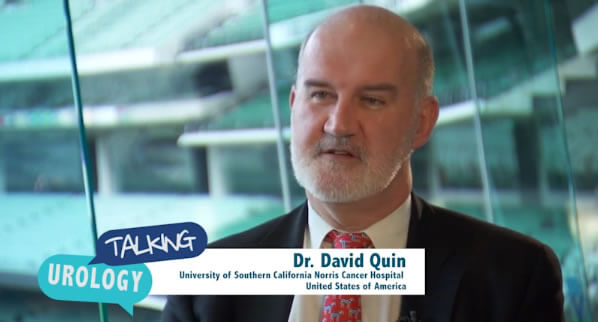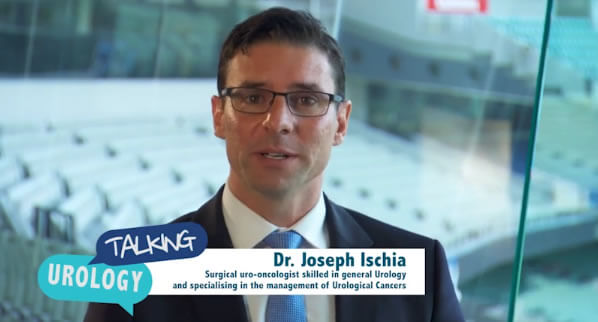ANZUP 2018 – A/Prof Laurence Albiges and Dr Monty Pal
A/Prof Laurence Albiges and Dr Monty Pal discuss the changing landscape and biomarkers in metastatic renal cell carcinoma with A/Prof Andrew Weickhardt
Talking Urology Podcast Transcript
ANZUP 2018 Interviews – Laurence Albiges and Monty Pal
Andrew Weickhardt: I’m Andrew Weickhardt and I am here with Laurence and Monty, talking about their fantastic insights they’ve provided today on kidney cancer. So, Laurence, I wanted to start with you. You gave a talk about kidney cancer and where we are with the evidence of current data from clinical trials. Can you talk about the highlights from the trials?
Laurence Albiges: Absolutely. So, it’s been a decade that we’ve used VEGF inhibition as gold standard in metastatic kidney cancer. We, for two years now, have access to immune checkpoints namely Nivolumab as single agent in second-line. What is happening now is that these agents are moving to first-line, and we have data that demonstrates that a combination of two checkpoint inhibitors Nivolumab plus Ipilimumab will be the new standard of care in patient in first-line because demonstrating overall survival benefit when compared to Sunitinib in the population of patients that have metastatic disease with intermediate or poor risk disease. So, that represents grossly 80% of our patient population for which the first-line is now changing.
Andrew: So, in that trial where there was a comparison between Ipi and Nivo compared to Sunitinib, what sort of responses were seen in patients treated with a doublet immunotherapy and how does that compare to a single-agent immunotherapy when it is used in, say, the second line?
Laurence: So, the results we have can be measured through three end-points. The first one is the response rate. So, meaning the percentage of patients that has a tumor shrinkage of more than 30% and it is 42% of our patient that have partial or complete response. This is very important because it compares well to the 27% of Sunitinib. The other end-point is progression-free survival, meaning the time to disease progression and here there is an increment of more than three months when compared to Sunitinib. And lastly and most importantly, it’s the overall survival benefit where the median is not reached yet for the combination where it has a ratio of 0.63, so meaningful difference in overall survival when compared to Sunitinib. Your question was comparing with Nivolumab single agent second line. I think we should not compare first-line and second-line, but obviously the doublet is potent and more potent than single agent.
Andrew: What about toxicity? That’s an issue which we’re now realizing with doublet immunotherapy that the toxicity profile is quite different from single-agent Nivolumab or just even a TKI. So, how do patients tolerate the doublet immunotherapy?
Laurence: I think this is a very important point, and we have to raise awareness within the community about this point. It is about 46% of our patients that have high-grade toxicity when exposed to the doublet Nivolumab plus Ipilimumab. It’s actually less than Sunitinib, but it’s more challenging to handle because it can be any kind of autoimmune disease and this toxicity usually lead to treatment discontinuation. In the trial it was 22% of the patient that had to discontinue because of toxicity when it’s only 12 for sunitinib for instance, so it means that whoever is using this agent in combination needs to be connected to a great network of specialists on how to handle GI toxicity, lung toxicity, endocrine toxicity for instance, all these things that we need to be aware of and that can happen with this combination.
Andrew: One question I have that interests me with the combination is what sort of toxicities would prompt you to stop all immunotherapy and what sort of toxicity would prompt you to just drop the ipilimumab from the combination and just continue on single agent?
Laurence: I am not sure we have evidence-based medicine to answer that point. It will be, you know, just getting with the experience. Whenever you have a rash, for instance, that is not a toxicity that would lead you to discontinue. However, we can have more acute toxicity especially neurological toxicity, myasthenia, for instance. There is a lot of wide-range of toxicity we’d actually require at least to withhold, discontinue, ask maybe for a second opinion based on specialists and define if we want to resume treatment with the combination and in the vast majority of case in the trial we had to use steroid as systemic therapy to prevent this autoimmune side effect.
Andrew: Is the toxicity profile in the trial, is that worse for the immunotherapy arm as compared to Sunitinib? I mean what proportion of patients had to stop Sunitinib in the trial, for instance, because of toxicity?
Laurence: It’s in the range of 9% to 12%. So, it’s less than with IO doublet obviously, but bear in mind that we are still in the learning curve on how to manage those side effects and within a trial of course you prefer to discontinue if you consider that it is not safe enough, maybe when getting into a larger community with more awareness on how to manage those side effects, we may be able to sustain maybe single-agent Nivolumab because what needs to be understood is that when we discuss doublet, it’s actually four infusions of the two compounds, then it’s maintenance with Nivolumab single-agent, and so the question is how many of those four initial cycles we are doing with the doublet depending on the toxicity.
Andrew: You also discussed some data from the Atezolizumab, Bevacizumab and combination VEGF inhibitor plus IO. How does the data compare and what do you think will sort of pan out with the use of that VEGF plus IO combination?
Laurence: What is important to be understood here is that this is the first randomized phase III of the combination of immune checkpoint plus VEGF inhibition in first-line setting. The first to be reported. It was reported a few months ago at ASCO GU. What is being demonstrated in this study is that once again when comparing to Sunitinib as one of the standard in first line, the combination of Atezolizumab plus Bevacizumab is doing better in terms of progression-free survival, but in a specific population which is what we call biomarker-driven, so PD-L1 positive patient roughly 40% of the patients. That was the target of this trial. However, the trial also provided insight on the overall population, what we call the intention to treat. So, this include also PD-L1 negative patients and the trial is still positive in this population in terms of progression-free survival. The data for overall survival are not mature yet. There is a very strong signal and it’s very likely that in future analysis, we’ll have the overall survival benefit, but it is not reached yet. I believe that for us in the community, it means that this combination is not ready yet to be filed for approval, and so on. So ,it’s a clear move forward because combining two different classes of drug actually help us to cover any subgroup of the disease, good-risk patient, intermediate, poor, and it works both in the PD-L1 positive and PD-L1 negative. However, the data are not yet mature enough for this combination to be available.
Andrew: Thanks. I might ask Monty a question about the combination of Atezolizumab and bevacizumab. You gave a commentary at ASCO GU this year and weighing the positives against the combination of Ipi and Nivo. If the trial rates are positive with overall survival, do you think that toxicity advantage favors that an Atez-Bev that will be taken up enthusiastically.
Monty: Yes, I agree with many of the perspectives that Laurence shared around toxicity with Nivo and Ipi and that’s something that concerns me, are these 24% discontinuation rates. I think that once the drug hits the community, once this regimen is out there, I think there are a lot of community-based oncologist who are going to be having trouble managing the AE profile of Nivo and Ipi and that actually makes a combination like Bev-Atez so far more appealing.
Andrew: So, you gave a talk this morning which is an insight into non-clear cell kidney cancer. Can you talk about the data that is out there that supports first-line and second-line treatment strategies in that more challenging population?
Monty: Yes, absolutely. I think the main focus is sort of the lack thereof, right? But unfortunately there is a real paucity of data these days and to our credit, I think that the investigative community has tried to do some trials juxtaposing VEGF inhibitors and MTOR inhibitors. But the real challenge that we face is that all the trials are non-clear cell that have been reported out to date in a randomized fashion, have really focused principally on the one thing together, multiple subsets of histologies – papillary, chromophobe, a translocation, and we know that there are huge biological differences that underlie each one of these. So, some of the studies that were reported out more recrently, for instance Laurence’s experience with Chris papillary RCC and experience with Toni Choueiri and Laurence and several others reported out with Savolitinib. I think that all these take much more focused approach that is biologically oriented that stands to make a much bigger dent in the disease.
Andrew: So, traditionally where you have described non-clear cell carcinoma into papillary and chromophobe, it seems that genetic testing is essential perhaps to identify some of those subgroups. So, can you talk about the data regarding MET amplifications and mutations that might be seen in papillary cancer but has driven some of those trials?
Monty: Well, I think now there is good rationale for getting genomic profiling, right. One of the big challenges that we had previously is you could have a genomic profile for a patient who had very little to do with it. You know, the study that Tony Choueiri is leading called the SAVOIR trial incorporates a randomization between Sunitinib and Savolitinib specifically in those MET-mutated patients. So, now, folks out in the community that have access to and can perform genomic profiling can ascertain their MET status and really drive themselves towards these studies. There are a lot of advocacy groups that are behind efforts to promote this.
Andrew: And is the technology there for me as a doctor to be able to order genetic tests on circulating DNA without having to get a biopsy from one of these sites? You have done some studies looking at the role of circulating tumor DNA.
Monty: Yes, using a commercial platform from Gardin we identified that circulating tumor DNA could be isolated from about 80% of patients with advanced disease. These patients had a wide-array of variations in disease burden. Certainly, higher disease burden tends to correlate with yield of CT DNA but it is feasible.
Andrew: Thank you so much for talking with me today and providing your insights. I look forward to the debate tomorrow on the CARMENA trial. It should be fantastic. Enthusiastically waiting to hear the arguments for and against the approach advocated in that trial.












